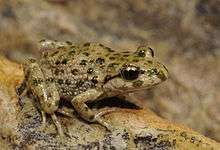Iberian parsley frog
| Pelodytes ibericus | |
|---|---|
 | |
| Scientific classification | |
| Kingdom: | Animalia |
| Phylum: | Chordata |
| Class: | Amphibia |
| Order: | Anura |
| Family: | Pelodytidae |
| Genus: | Pelodytes |
| Species: | P. ibericus |
| Binomial name | |
| Pelodytes ibericus Sánchez-Herráiz, Barbadillo, Machordom & Sanchiz, 2000 | |
 | |
The Iberian parsley frog (Pelodytes ibericus) is a species of frog in the Pelodytidae family,[2] known as "parsley frogs" because of their green speckles.[3] This species is only found in Portugal and Spain;[2] in Spanish it is known as sapillo moteado ibérico.[1]
Description
Adult Iberian parsley frogs attain a length of about 4 centimetres (1.6 in) and look very similar to the common parsley frog (Pelodytes punctatus, its sister species[2]) but are a little smaller with shorter limbs. The skin is smooth or granular with a scattering of dark-coloured tubercles. The dorsal surface varies from olive, greenish-brown, dark brown or greenish-grey and is flecked with green specks. The undersurface is white or cream and the throat of breeding males is dark-coloured.[3]
Distribution and habitat
The Iberian parsley frog is endemic to the Iberian Peninsula.[1][2] It is quite common in suitable habitats in Spain but seems to be rare in Portugal. It occurs in open areas, under bushes, among scattered trees, in salt marshes, fields and gardens. It can continue to live in intensively farmed areas.[1]
Breeding
Breeding takes place in the spring, often after heavy rain. Eggs are laid in ponds, ditches, slow-moving streams and flooded areas. Egg masses contain up to 350 eggs and several clutches may be laid over the course of a few days. The eggs hatch after about a fortnight and the tadpoles may take about three months to develop before undergoing metamorphosis into juvenile frogs.[3]
Conservation status
This frog has a wide range and the overall population seems to be reasonably stable. The International Union for Conservation of Nature (IUCN) rates it as being of "Least Concern" as it considers that the rate of decline, if any, is insufficient to justify listing it in a more threatened category. This frog is common over much of its range and the threats it faces have been identified as degradation of its habitat, the loss of its breeding pools, and the predation of the invasive freshwater crayfish Procambarus clarkii.[1]
References
- 1 2 3 4 5 Jaime Bosch; Miguel Tejedo; Miguel Lizana; Pedro Beja; Iñigo Martínez-Solano; Alfredo Salvador; Mario García-París; Ernesto Recuero Gil; Rafael Marquez; Carmen Diaz Paniagua; et al. (2009). "Pelodytes ibericus". IUCN Red List of Threatened Species. Version 2013.1. International Union for Conservation of Nature. Retrieved 2013-12-11.
- 1 2 3 4 Frost, Darrel R. (2014). "Pelodytes ibericus Sánchez-Herraíz, Barbadillo-Escrivá, Machordom, and Sanchíz, 2000". Amphibian Species of the World: an Online Reference. Version 6.0. American Museum of Natural History. Retrieved 10 March 2014.
- 1 2 3 Arnold, Nicholas; Ovenden, Denys (2002). Reptiles and Amphibians of Britain and Europe (2nd ed.). Harper Collins. pp. 72–73. ISBN 9780002199643.
